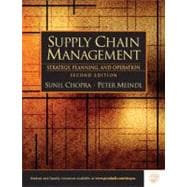
Note: Supplemental materials are not guaranteed with Rental or Used book purchases.
Purchase Benefits
What is included with this book?
| Building A Strategic Framework To Analyze Supply Chains | |
| Understanding the Supply Chain | |
| Supply Chain Performance: Achieving Strategic Fit and Scope | |
| Supply Chain Drivers and Obstacles | |
| Designing The Supply Chain Network | |
| Designing the Distribution Network in a Supply Chain | |
| Network Design in the Supply Chain | |
| Network Design in an Uncertain Environment | |
| Planning Demand And Supply | |
| Demand Forecasting in a Supply Chain | |
| Aggregate Planning in the Supply Chain | |
| Planning Supply and Demand in the Supply Chain: Managing Predictable Variability | |
| Planning And Managing Inventories In A Supply Chain | |
| Managing Economies of Scale in the Supply Chain: Cycle Inventory | |
| Managing Uncertainty in the Supply Chain: Safety Inventory | |
| Determining Optimal Level of Product Availability | |
| Sourcing, Transporting, And Pricing Product | |
| Sourcing Decisions in a Supply Chain | |
| Transportation in the Supply Chain | |
| Pricing and Revenue Management in the Supply Chain | |
| Coordination And Technology In The Supply Chain | |
| Coordination in the Supply Chain | |
| Information Technology and the Supply Chain | |
| e-business and the Supply Chain | |
| Table of Contents provided by Publisher. All Rights Reserved. |
The New copy of this book will include any supplemental materials advertised. Please check the title of the book to determine if it should include any access cards, study guides, lab manuals, CDs, etc.
The Used, Rental and eBook copies of this book are not guaranteed to include any supplemental materials. Typically, only the book itself is included. This is true even if the title states it includes any access cards, study guides, lab manuals, CDs, etc.